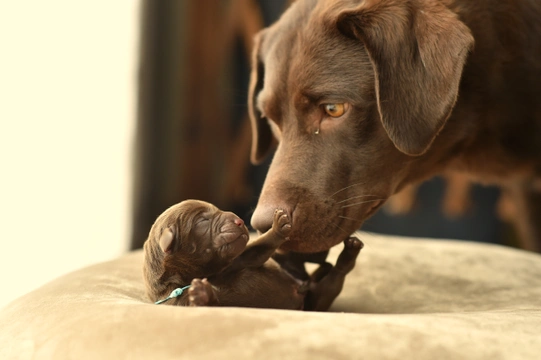
8 signs of labour in dogs (and how to support your dam)
Your girl is pregnant, puppies are coming soon….and now you may be panicking. How will you know she is starting to give birth? What will she do? Will we know what to look for? These are all common questions asked by new and understandably nervous owners of pregnant dogs.
We understand that knowing what you are looking for in terms of common behaviours and physical signs will help to lower owners anxieties and help you feel more prepared for your first appearance as a canine midwife.
Canine Pregnancy lasts on average 63 days. However viable puppies can arrive from as early as day 58, and as late as day 68. The dog labour itself is made up of 3 stages and can take over 24 hours from start to end. So what are the first signs a dog is in labour?
8 signs of labour in dogs
- Take her temperature
Experienced breeders monitor the rectal temperature from 10 days prior to birth. The normal range is 37.5-38.5 degrees. The temperature will drop to around 36 degrees, just prior to the 1st stage of labour beginning and is a really good indicator that you need to be on standby.
- Monitor her food and water intake
Often before labour a female will lose her appetite and refuse food and water, this can be a sure sign that babies are on the way.
- Mucus Plug
As the cervix prepares for the birth the mucus plug will break down and can often be seen as a clear stringy discharge. Keep your eyes peeled, puppies won’t be long now.
- Digging & Nesting
As the day draws nearer your bitch may start to dig up her bed, or in some cases start to prepare a nest elsewhere in readiness for her new arrivals. This is natural behaviour linked to the hormone production in pregnancy.
- Withdrawal
Bitches often seek a safe quiet space, away from the family and other dogs, if your female is taking herself off to a quiet spot, chances are she is sizing that spot up for a whelping area!
- Enlarged teats
As her body prepares to feed the puppies her mammary glands will start to enlarge and change shape. Some females even leak milk prior to the birth.
- Dropped belly
As the bitch gets closer to birthing her belly sometimes looks “dropped” and they look hollow across their backs. This is the puppies moving into position prior to delivery.
- Panting
If your bitch is seen excessively panting she could be starting. Panting is a sign of pain in dogs, and can be an indicator that early labour is in progress!
These signs can happen to some bitches and not others, and remember no whelping two whelpings are ever the same. Watch closely, and monitor your pregnant female if you see any of these signs.
How to help a dog give birth for the first time
Being a Canine Midwife requires you to be prepared, remain calm and act if required. Being prepared means having the right kit, here is a list to our whelping essentials;
https://pupstartsbreeders.com/whelping-kit-essentials/
As soon as labour starts, inform your vet. You may need their help and advice, so make sure they are aware that your dog is in labour.
Remain calm. This is very important. Your dog will pick up on your emotions and if you are worried and panicking, so will she. Stay with her, reassure her and take notes on how the labour is progressing. If you are worried that the labour is not progressing as it should or that your female is in distress your vet will be able to advise you on the next steps.
Keep the house quiet and ensure that your female has the space and the peace to deliver her litter. Even the most sociable bitches want to be alone for the delivery, ensuring she has privacy and she is comfortable with her surroundings.
Stay near to her. She may not want you right next to her, but keep a close eye on how the labour is progressing, bitches usually whelp at night and it can be a very long drawn out process for some, but she needs you to be monitoring the progress and she needs you to take action if required.
When to contact your vet for help
Dogs have been delivering puppies for many many years, and usually there are no issues. There are some breeds that require veterinary intervention more routinely, but overall whelping goes smoothly. Troubleshooting the whelping can be the trickiest part, check out our troubleshooting guide for more information.
This article is a guest post kindly contributed by Rebecca Walters of Pupstarts Breeders. Pupstarts provide dog breeding courses to help ethical dog breeders to breed, whelp and raise puppies responsibly, safely and with absolute confidence. www.pupstartsbreeders.com



